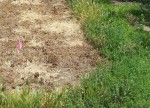 No matter how much you value your lawn and lavish time and money on it, bad stuff happens and the time may come when you decide to start over and put in a new lawn. This is not a decision to be made lightly as the job is arduous and filled with problems and pitfalls. One of the first steps, getting rid of the old turf, can be difficult as well as expensive.
No matter how much you value your lawn and lavish time and money on it, bad stuff happens and the time may come when you decide to start over and put in a new lawn. This is not a decision to be made lightly as the job is arduous and filled with problems and pitfalls. One of the first steps, getting rid of the old turf, can be difficult as well as expensive.
Your old lawn may be grass, weeds, or a combination but the procedure is the same. You have a choice of chemical or physical methods and both may be necessary.
Chemical:
Perhaps the simplest method is to get a general herbicide like Roundup but other herbicides that contain glyphosate will work too. Roundup is generally considered safe and will kill a large variety of plants if used properly. Follow all the safety precautions listed on the package and be especially careful to keep children and pets from the sprayed area for a week until the herbicide has degraded. You will probably have to spray several times to kill all the grass and weeds. Spray on a windless day and avoid spraying trees and shrubs. There is always some drift as you spray and it can cause damage to any plant material that it touches. When you are sure all the weeds and grass are dead wait a week before seeding to allow the herbicide to degrade.
Physical:
There are three general approaches:
 Cutting the Sod
Cutting the Sod
Rent a sod cutter, cut the sod and turn it over to expose the roots to the sun so they dry out and die. You will have a lot of debris but can pitch it into the compost pile.
 Black Plastic
Black Plastic
By securing black plastic over the grass and weeds you deprive them of light and raise the temperature which leads to their demise. The plant material will slowly die and so this method may take months to work depending on the temperature and rainfall. Beware, the stems and leaves will die first and appear to be dead; the roots may take longer and you will have a harder time determining if they are dead. Many weeds can produce a whole new plant from a small piece of root. This method will probably not kill weed seeds either. And it is very unsightly.
 Tilling, plowing, bulldozing
Tilling, plowing, bulldozing
These methods probably require the renting of machinery and the ability to work the machinery. If you decide to till, get a rear-tined tiller for ease of handling. Be sure the tiller you have can till to a depth of 4-8”, as many do not. You may have to till and rake several times to get out all the weeds and grass.
Plowing is similar to tilling but you can plow to a deeper depth. If you have a riding mower with sufficient horse power you may be able to pull a small plow with it to do the job. Again, raking out the debris is essential.
Bulldozing can scrape the top few inches off the lawn, taking most of the debris, but the debris will have to be placed somewhere. Perhaps make it into a compost pile.
When you look over the possible ways of clearing your land of weeds and old grass you will probably come to the conclusion that a lot of work is involved. The use of an herbicide is not appealing, but the aesthetic problems of the black plastic and the physical demands of the other methods may make the use of an herbicide acceptable.
